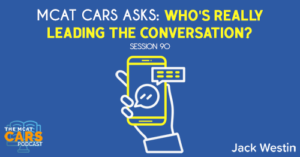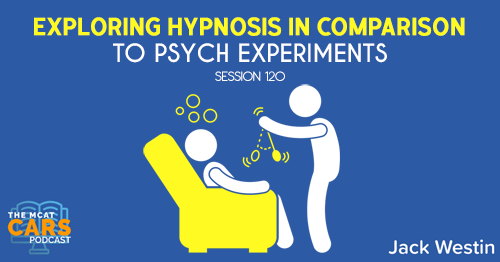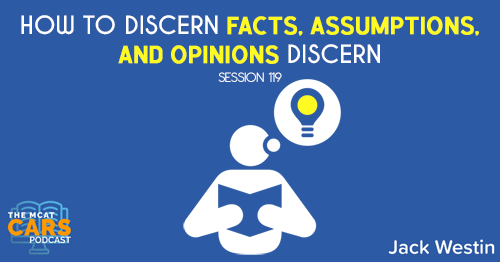Apple Podcasts | Google Podcasts
Session 90
UX writers play a critical role in driving how we interact with technology. In today’s MCAT CARS practice passage, we look at what they do and why it matters.
As always, I’m joined by Jack Westin from JackWestin.com. Check out all their amazing free resources including a free trial session of Jack’s full course to see how it’s like learning from Jack Westin himself.
Listen to this podcast episode with the player above, or keep reading for the highlights and takeaway points.
Link to the article:
https://reallifemag.com/look-whos-talking/
First we learned to speak how computers seemed to want us to. Best pizza Chicago, we might type into the search bar, dropping yet another preposition. Hit submit, someone might say, punctuating a dreary task with a rhyme that sounds like two verbs but isn’t. Now computers sound increasingly like people. This isn’t just a matter of Alexa and its competitors, or the chatbots that respond when you message brands. While the technologies that enable human-machine “conversation” — speech synthesis, natural language processing — have advanced a lot over the past decade, engineering alone can’t yet breathe life into most interfaces. What is human-like in them is often due to the way they are written.
User-experience (UX) design is the process of ensuring that websites, apps, and other products meet the needs of their intended users, at least to the extent that those needs can help generate revenue. Discussions of UX tend to focus on how things look (the color of a button, the placement of a menu) and how they work (what happens when you click or tap). But the way they sound or read is increasingly just as meticulously designed. UX writers — who may also have titles like product writer, content designer, or content strategist — do a lot of different things depending on where they work. They might write help content, emails, or error messages (“We’ve seen this problem clear up with a restart of Slack, a solution which we suggest to you now only with great regret and self-loathing”). They might script digital assistants and chatbots (“What can I help you with?”). They might compose the text that tells you what will happen if you click on a link, button, or menu. (Perhaps you’ve noticed that “learn more” is losing ground to more specific pleas like “read the full story.”) When you use a consumer app, website, or device created by a large technology company, a UX writer has probably had a hand in the words you’re interacting with.
One of UX writing’s main directives is to make interfaces sound “human,” “natural,” or “conversational.” Amazon’s instructions for people writing Alexa scripts include tips like, “Use variety to inject a natural and less robotic sound into a conversation and make repeat interactions sound less rote or memorized.” Across organizations, guidelines urge the use of contractions, first- and second-person pronouns, and words that people on the other side of the device might say. Recently, when a cash register expressed hope that I’d had a good “Target run,” I thought, Hey, that’s what my mom calls it too! The writer for the self-checkout kiosks had hit their mark.
Sara Wachter-Boettcher, in her 2017 book Technically Wrong, dates the current “talk-like-a-human movement in tech products” to 2011. This was the year Apple launched Siri and IBM’s Watson won Jeopardy! But Wachter-Boettcher doesn’t mention these events; she thinks the email marketing company Mailchimp kindled the trend with its then new voice and tone guidelines. The guidelines, which soon started “popping up in countless conference talks as the way forward for online communication,” framed Mailchimp’s relationship with customers as explicitly conversational. They used speech bubbles to demonstrate the tone the company’s writers should take for a variety of types of content. The idea was that Mailchimp should modulate its voice, as a person would, depending on the situation of whomever it was talking to. All the while, the voice itself should remain recognizable. Mailchimp defined this voice as having eight consistent parameters, the first two of which were “fun but not childish” and “clever but not silly.”
[03:26] Paragraph 1, Sentence 1
First we learned to speak how computers seemed to want us to.
Jack says:
This is quite confusing. Maybe the computer only understands things a certain way. So we have to speak in that way. At least, this sentence tells you we’re talking about computers. We’re talking about speaking.
'Every single sentence fills in a piece of the puzzle. As long as you keep reading and you keep going with these puzzle pieces, they're going to be able to connect them.'Click To TweetThis is where a lot of students start rereading and thinking about skipping this passage. Those are things you’re saying yourself because you’re insecure, to some extent, as a test taker. And that’s fine. But you have to be aware that’s happening. You shouldn’t let this intimidate you.
[04:53] Paragraph 1, Sentence 2
Best pizza Chicago, we might type into the search bar, dropping yet another preposition.
Jack says:
So we might type into the search bar dropping yet another preposition, so preposition being “in” for “best pizza in Chicago.”
We just dropped it and said best pizza Chicago. So why would the author say this? What is this trying to convey? It’s giving us an example of how computers seem to want us to speak. Nobody knows. But Google can figure it out.
[05:48] Paragraph 1, Sentence 3
Hit submit, someone might say, punctuating a dreary task with a rhyme that sounds like two verbs but isn’t.
Jack says:
Again, it’s speaking how we speak in computer terms when we’re googling something.
[06:20] Paragraph 1, Sentence 4
Now computers sound increasingly like people.
Jack says:
The first sentence was first, we learned to speak how computers seem to want us to. Now, the author here says that the computer sounds increasingly like people. So maybe computers are getting better.
[07:10] Paragraph 1, Sentence 5
This isn’t just a matter of Alexa and its competitors, or the chatbots that respond when you message brands.
Jack says:
It’s not just Alexa. It’s not just the chat bots.
[07:49] Paragraph 1, Sentence 6
While the technologies that enable human-machine “conversation” — speech synthesis, natural language processing — have advanced a lot over the past decade, engineering alone can’t yet breathe life into most interfaces.
Jack says:
Now, we switch a little bit into the conversation of the technology behind this. Engineering alone can’t breathe life into these interfaces, meaning they can’t make a more human yet.
So that begs the question, what’s making Alexa more human? What’s making these things more conversational?
[08:36] Paragraph 1, Sentence 7
What is human-like in them is often due to the way they are written.
Jack says:
The author is making a distinction between the engineering, the coding of it, and the actual speech, the actual writing of it. That’s a little hard to understand. But you don’t have to understand computer science to get this. You just have to know that how it’s written is not the same thing as engineering it. You can just visualize that to the best of your ability. But you have to know there’s a difference between writing it and engineering it.
[09:49] Paragraph 2, Sentence 1
User-experience (UX) design is the process of ensuring that websites, apps, and other products meet the needs of their intended users, at least to the extent that those needs can help generate revenue.
Jack says:
That’s what user experience design is for. And the author here is specifically saying that it’s really for generating revenue. You don’t need to know a lot about user experience design. But it does give you some details as to what it does. It helps with the websites and the apps. It helps meet the needs of their users.
[10:40] Paragraph 2, Sentence 2
Discussions of UX tend to focus on how things look (the color of a button, the placement of a menu) and how they work (what happens when you click or tap).
Jack says:
The author is giving a brief little background on what UX is.
[11:01] Paragraph 2, Sentence 3
But the way they sound or read is increasingly just as meticulously designed.
Jack says:
So it’s going back to how they’re written. Those user interfaces or the interaction with the computers is now meticulously designed. We’re shifting gears here from goin, what happens when you click on this page to talking more about what UX is. So it’s maybe going back to writing.
[11:40] Paragraph 2, Sentence 4
UX writers — who may also have titles like product writer, content designer, or content strategist — do a lot of different things depending on where they work.
Jack says:
Here’s a little bit more background here into the UX world and who is working on UX and who these UX writers are. There seems to be another distinction here, the UX designer and the UX writer. And it’s like what we said in the previous paragraph with the engineering and the writing.
[12:17] Paragraph 2, Sentence 5
They might write help content, emails, or error messages (“We’ve seen this problem clear up with a restart of Slack, a solution which we suggest to you now only with great regret and self-loathing”).
Jack says:
It’s an example of what these UX writers may write and an example of a silly error message. It’s in parenthesis, and it’s quoting. So it’s probably some kind of error message from some company. You don’t need to know Slack.
[12:55] Paragraph 2, Sentence 6
They might script digital assistants and chatbots (“What can I help you with?”).
Jack says:
Some more examples there.
[13:06] Paragraph 2, Sentence 7
They might compose the text that tells you what will happen if you click on a link, button, or menu.
Jack says:
And more examples of who these UX writers are.
[13:17] Paragraph 2, Sentence 8
(Perhaps you’ve noticed that “learn more” is losing ground to more specific pleas like “read the full story.”)
Jack says:
It’s an example of these UX writers getting a little bit more creative.
[13:35] Paragraph 2, Sentence 9
When you use a consumer app, website, or device created by a large technology company, a UX writer has probably had a hand in the words you’re interacting with.
Jack says:
This is all going back to the idea that computers now sound more like people. Their writing is just as important as the actual design.
[14:32] Paragraph 3, Sentence 1
One of UX writing’s main directives is to make interfaces sound “human,” “natural,” or “conversational.”
Jack says:
There’s this directive to make it more human and natural, and not what a computer would say. It’s like talking to Siri or Alexa. They’re not perfect, but they sound more human.
[15:07] Paragraph 3, Sentence 2
Amazon’s instructions for people writing Alexa scripts include tips like, “Use variety to inject a natural and less robotic sound into a conversation and make repeat interactions sound less rote or memorized.”
Jack says:
So Amazon is directly telling developers what to do to make them sound more conversational or natural.
[15:50] Paragraph 3, Sentence 3
Across organizations, guidelines urge the use of contractions, first- and second-person pronouns, and words that people on the other side of the device might say.
Jack says:
Again, this is just an example of being more human, more natural.
[16:08] Paragraph 3, Sentence 4
Recently, when a cash register expressed hope that I’d had a good “Target run,” I thought, Hey, that’s what my mom calls it too!
Jack says:
It brings out this kind of feeling of joy from the user.
[16:40] Paragraph 3, Sentence 5
The writer for the self-checkout kiosks had hit their mark.
Jack says:
The author here says they did a good job. They made it natural and conversational. They made it just like what my mom would say.
[17:09] Paragraph 4, Sentence 1
Sara Wachter-Boettcher, in her 2017 book Technically Wrong, dates the current “talk-like-a-human movement in tech products” to 2011.
Jack says:
We’re given here a book and the movement that the book author calls it “talk like a human movement in tech products” which started in 2011.
[17:45] Paragraph 4, Sentence 2
This was the year Apple launched Siri and IBM’s Watson won Jeopardy!
Jack says:
The author mentions two big events here.
[18:02] Paragraph 4, Sentence 3
But Wachter-Boettcher doesn’t mention these events; she thinks the email marketing company Mailchimp kindled the trend with its then new voice and tone guidelines.
Jack says:
The example is Apple launching Siri and IBM Watson, but the book says it was MailChimp. As long as you know the history of it and we’re talking about that, we can always come back to the details. But we’re trying to figure out where this actually started.
The MCAT will have answer choices that correspond with whether or not this was an era where technology was relevant or not relevant. So you don’t need to know these details.
The problem students have is they think the questions directly come from the passage. The questions don’t have to really directly come from the passage. They’re not going to ask you what did this person or what is this detail or that detail. What they’ll do is say, based on this passage or based on everything that you’ve read in this passage, what would follow? So it’s not necessarily in the passage, but it’s something relevant to the passage. What they’re really testing is if you understand the flow of the passage.
'The key is they're going to ask you questions about understanding, and not necessarily about memorization.' Click To Tweet[20:59] Paragraph 4, Sentence 4
The guidelines, which soon started “popping up in countless conference talks as the way forward for online communication,” framed Mailchimp’s relationship with customers as explicitly conversational.
Jack says:
This is a discussion here right of how MailChimp led the way about the relationship being explicitly conversational.
[21:32] Paragraph 4, Sentence 5
They used speech bubbles to demonstrate the tone the company’s writers should take for a variety of types of content.
Jack says:
These are examples of how MailChimp is really focused on conversational kind of interactions with our customers.
[22:16] Paragraph 4, Sentence 6
The idea was that Mailchimp should modulate its voice, as a person would, depending on the situation of whomever it was talking to.
Jack says:
So it’s just saying it’s talking like a human and it seems so revolutionary.
[22:39] Paragraph 4, Sentence 7
All the while, the voice itself should remain recognizable.
Jack says:
It means you immediately know it’s MailChimp talking to you.
[22:54] Paragraph 4, Sentence 8
Mailchimp defined this voice as having eight consistent parameters, the first two of which were “fun but not childish” and “clever but not silly.”
Jack says:
They’re defining who they are with these things. They’re trying to maintain this type of tone or personality to keep it recognizable.
[23:08] Main Idea
The UX writers are a very important part of how we interact with technology and they are making it more human. The UX writing is leading to more human natural-sounding technological interfaces – voices, not necessarily just the engineering
You would think it’s all about the algorithms, and it’s all about the coding. But it’s not. It’s about the actual person typing in the right responses and the right content that seems to be playing a bigger role these days.
As long as you know, how the author really thinks that UX writers are to blame for the more conversational kind of interfaces, then you’re fine.
[24:38] Possible MCAT Questions
Again, it’s hard enough to understand that there’s a distinction between engineering and writing. Jack thinks that’s really what they’re going to test you on.
A good question that they could ask is supposed that it was found that the code written leads to more conversations, what can we assume or suggest about this passage?
Then the answer is what challenges the main idea. That is their way of presenting an opinion. That goes against what the author said by suggesting that there is code that could lead to more conversations that suddenly weakens the main idea.
So you need to pick up on that in the question stem and pick an answer that correlates with that question. The question is suggesting that the code or the engineering is more important than anything else that leads the conversation. So you have to pick an answer that says challenges, not supports.
The answer choices will have two answers that say challenges and two answers that say support. And your job is to find the one that challenges the main idea.
This is a behavior that the author is trying to generalize. And that’s what opinions really are. It’s trying to generalize based on behavior we’ve seen. So we see writers do something, then we can generalize that all writers are making it more conversational. We have to be very careful when we make opinions because there might be exceptions.
'Where really strong CARS test takers excel is they're very careful and pay attention to exactly what's being said so they don't make any mistakes.'Click To TweetLinks:
SEARCH SITE
SEARCH SITE
LISTEN FOR FREE












